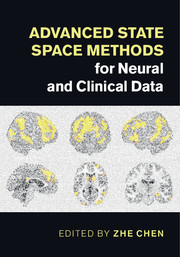Preface
Published online by Cambridge University Press: 05 October 2015
Summary
In the modern age of the digital world, gigantic amounts of data have been recorded or collected. It remains a great challenge to process and analyze the “big data”. Many neurophysiological, physiological, clinical and behavioral data are dynamic by the nature of the experiments or the way they are collected. These signals could be complex, noisy, and often multivariate and multimodal. How to develop efficient statistical methods to characterize these data and extract information that reveals underlying biological or physiological mechanisms remains an active and important research topic. In recent years, numerous advanced computational statistics, signal processing, and machine-learning methods have been developed and there is rapidly growing interest in applying these methods to data analysis in neuroscience, physiology and medicine.
The state space model (SSM) is referred to a class of probabilistic graphical models (Koller & Friedman 2009), which describe the probabilistic dependence between the latent state variable and the observed measurement. The state or the measurement can be either continuous or discrete. The term “state space” originated in 1960s in the area of control engineering (Kalman 1960). SSM provides a general framework for analyzing deterministic and stochastic dynamical systems that are measured or observed through a stochastic process. The SSM framework has been successfully applied in engineering, statistics, computer science and economics to solve a broad range of dynamical systems problems. The most celebrated examples of SSM include the linear dynamical system and the associated inference algorithm: Kalman filter (Kalman 1960), and the hidden Markov model (HMM) (Rabiner 1989). Despite plenty of successful examples applying state space analyses to neural and clinical data, there remain many challenges in data analysis, for either developing new mathematical theories and statistical models, or developing efficient algorithms tuned for large-scale data sets, or catering for highly complex (multimodal or multiscale) and nonstationary data. In order to pave the way for further advancement in these research areas, it is important to recognize these challenges and exchange new ideas among researchers and practitioners.
It is important to point out that the modeling and analysis principles discussed in this book are general and equally valuable for time series analyses in many other disciplines, such as climatology, politics, finance, chemical engineering, consumer marketing and computer networking.
- Type
- Chapter
- Information
- Advanced State Space Methods for Neural and Clinical Data , pp. xix - xxiiPublisher: Cambridge University PressPrint publication year: 2015

